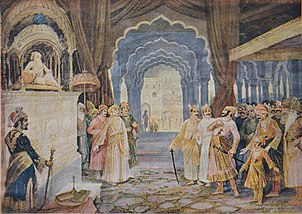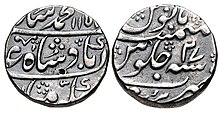Kingdom of Amber
[7][8] Upon integration, the ruler was granted a pension (privy purse), certain privileges, and the use of the title "Maharaja of Jaipur" by the Government of India.[13] Some historians associate Dulha Rao, the founder of the Jaipur Kachhwaha lineage, with the Kachchhapaghata dynasty that ruled over a part of Rajasthan and Madhya Pradesh in 10th century.According to Jadunath Sarkar, Dulha's grandfather Ishwar Singh, the ruler of Narwar, renounced his throne and divided his estate among his younger brother and his nephew and travelled North of Chambal to live a life of religious recluse.[15] M. L. Sharma suggests that Dulha was placed in Dausa particularly to help fight the Bargujar chief who partly controlled the city.Pajjun's successor Malesi consolidated power in Dhundar by marrying into neighboring regions and also may have defeated the ruler of Mandu in the battle of Rutroli.Prithviraj joined the Rajput Confederacy of 1527 led by Rana Sanga against Babur and fought in the Battle of Khanwa in which they were defeated.[30] Rana Sanga was poisoned by his nobles two months after the battle for insisting to continue fighting a lost war and Prithviraj died in November of the same year.During his reign, his uncle and son of Prithviraj, Sanga captured a part of territory and called it Sanganer where he was succeeded by his brother Bharmal.Soon, governor of Mewat, Mirza Muhammad Sharif-ud-din Hussain, who supported the cause of the son of Puranmal, Suja attacked Amber in 1558.[34] Feeling insecure after Sharif-ud-din's treaty, Bharmal, through his brother Rupsi, arranged a meeting with Mughal Emperor Akbar at Sanganer where they met in 1562.[36] Jodha Bai, now named Mariam-uz-Zamani also gained prestige in the Mughal court both during the reign of her husband and that of her son as Empress and Queen mother respectively.Bhagwant Das was an exceptional military general and he accompanied Akbar throughout his expansion of the Mughal Empire across Rajasthan, Gujarat, Kashmir and the Punjab.In order to strengthen the ties with Mughals, he married his daughter Manbhavati Bai to Akbar's son Prince Salim.Towards the end of 1604, Akbar fell ill. Man Singh planned on placing his grandson Prince Khusrau on throne instead of his rebellious son Salim.Dara sought refuge under Malik Jeevan but he was betrayed and turned in with Jai Singh who brought him back to Agra.Jai Singh made several bad attempts at battle in the next one month and spent a lot of his personal resources trying to make his dream Bijapur invasion happen but failed.This encouraged the major Rajput kingdoms, the Mewar, Marwar and Dhundar to form an alliance to fight against Bahadur Shah.Eventually, in 1710, Bahadur Shah decided to make peace with the Rajputs and accepted Ajit and Jai Singh as the rulers of their lands.[67] In 1719, Farrukhsiyar was murdered by Sayyid brothers and Ajit Singh and was replaced by Rafi-ud-Darjat and Rafi-ud-Daulah in quick successions and eventually settled for Roshan Akhtar who became Emperor Muhammad Shah.By this time, Sawai Jai Singh II had become a very influential person in India and he was looked upon by all major leaders including the Peshwa, Nizam and other fellow Rajputs.Marathas raided Rajputana, this time striking close to Jaipur, eventually obtaining even larger amounts of tribute in the form of chauth.The city had streets and lanes that intersect each other at right angles and havelis, temples, gardens, civic buildings were built at pre-planned places.Malhar Rao again laid siege to Jaipur in 1750, and Ishwari did not have enough force to defend so he consumed poison and killed himself leaving his throne for his brother Madho Singh.[4] After the civil war, Sawai Madho Singh was unable to repay the Marathas who frequently raided Jaipur from 1751 to 1759 and extracted ransom money, hurting the financial situation of Dhundhar.In 1787, Mahadji Scindia and his force led by General Benoît de Boigne invaded Jaipur but had to retreat after failure at the Battle of Lalsot.The Rao-Thomas alliance faced difficulty and were advised by the commander of Daulat Rao Sindhia, General Pierre Perron to retreat.The Jaipur rulers also made large scale punya-udik (charitable) grants to many Charans, Brahmans, Bhats (bards) and various Vaishnavite institutions.In this event, Jaipur's Ambassador to Lord Lake observed that "This was the first time, since the English government was established in India, that it had been known to make its faith subservient to its convenience".By 1867 its first batch had taken the matriculation examination from Calcutta University, by 1873 it had been raised to the ‘Intermediate’ level, and by 1875 its original forty students had grown to eight hundred.[citation needed] In 1869, Ram Singh II signed a treaty with the British Government to lease the Sambhar Lake for 2.75 Lakh rupees annually.












DhundharRajputanaImperial Gazetteer of IndiaTributary stateChauhansVassal stateKingdom of MewarMughal EmpireMaratha ConfederacyPrincely stateBritish East India CompanyIndian EmpireJaipurDhundariMonarchyMaharajaDulha RaiMan Singh IIIndian RupeeDominion of IndiaRajasthanRepublic of IndiaKachwaha RajputKachchhapaghata dynastyChahamanas of ShakambhariGaur dynastysheopurSisodiaBattle of KhanwaPrithviraj KachhwahaBharmalMughalsBhagwant DasRaja Man Singh IMirza Raja Jai Singh IShah JahanAurangzeb'sShivajiSawai Jai Singh IIIshwari SinghMadho Singh IMarathasEnglish East India Company rulesubsidiary allianceThird Anglo-Maratha Waraccededintegrated into Indiaprivy purseGovernment of IndiaKachwahaKosalaGwaliorJadunath SarkarChambalBargujarMeenasBargurjarSULTANATE(LODIS)(Babur)SHAH MIRSULTANATEKANGRAPHAGMODRUPASKHANDESHSULTANATEBERARSULTANATEMALWASULTANATEARGHUNSKALMATLANGAHSULTANATESHEKHAWATAMARKOTJAISALMERBIKANERGUJARATSULTANATEMARWARKARAULISIROHIDIMASATRIPWAKAMATASCHEROSBENGALSULTANATEGAJAPATIEMPIRETribalstatesAHMADNAGARSULTANATEVIJAYANAGARAEMPIREBIJAPURSULTANATEBIDARSULTANATEGOLKONDASULTANATEPajawanKumbha of MewarRana SangaMaldeo RathorePuranmalHumayunHindal MirzaBhim SinghSher Shah SuriRatan SinghSanganerAskaranJodha Bai'sSambharRaja Bhagwant DasManbhavati BaiPrince SalimYousuf Shah ChakRaja Man SinghMughalNavaratnasMan Singh IBattle of HaldighatiMirza Muhammad HakimRaja BirbalTodar MalJagannath temple at PuriRajmahalEmperor JahangirElichpurBhau SinghGovind Dev Ji TempleSarovar GhatMalik AmbarJai SinghJai Singh IPrince KhurramShahryar